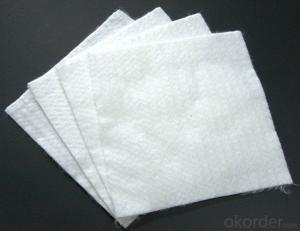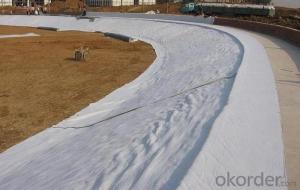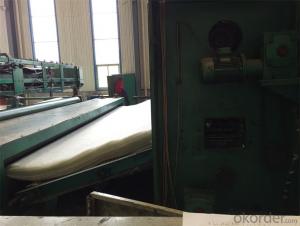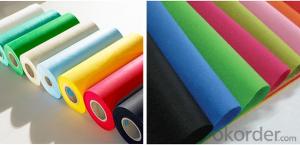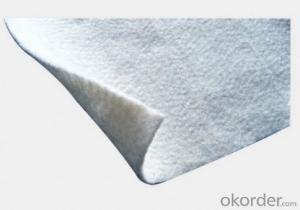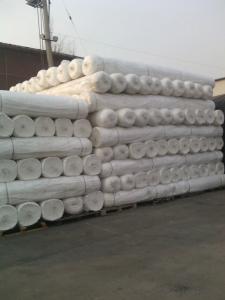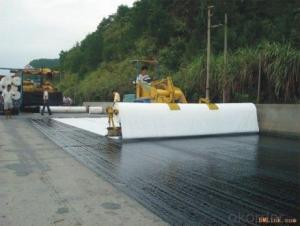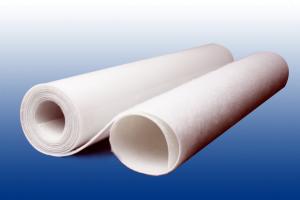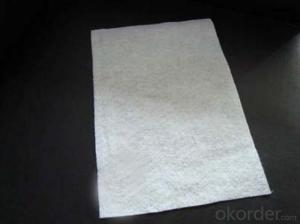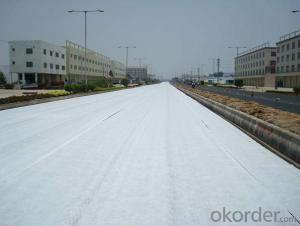Nonwoven Geotextiles - Filament Spunbond Needle Punched Geotextile
- Loading Port:
- Qingdao
- Payment Terms:
- TT or L/C
- Min Order Qty:
- 10000 m²
- Supply Capability:
- 100000 m²/month
OKorder Service Pledge
OKorder Financial Service
You Might Also Like
Product Description
Geotextiles also called geotextile fabrics, it’s permeable geosynthetics made of synthetic fibers through woven or needle punched.
Geotextiles including :needle punched nonwoven geotextile , filament woven geotextile , split yarm PP woven geotextile,composite geotextile + geomembrane,Geotextile Bags.
1) Staple fibers needle punched non woven geotextile
The geotextile is made of polypropylene staple fibers on cross-laying equipment and needle punched equipment.
It owns the advantages of acid and alkali resistance, erosion resistance, aging resistance, large strength, stable size, good filtrability etc.
2 ) Filament non woven geotextile
Filament geotextile has features as follows: High strength, good capacity of elongation and high biology tolerance, alkali tolerance, acidity tolerance, weather resistance good filtration and fine drainage capacity etc. Also it is of low cost, easy in construction and use effects.
Geotextile Technical Specifications
PP short fiber nonwoven geotextile fabric :
Serial numberItem\index\specification150200100250300350400450500600800Remark1Mass-area ratio deviation, %-8-8-8-8-7-7-7-7-6-6-62Thickness, mm≥0.91.31.72.12.42.73.03.33.64.15.03Amplitude, deviation,%-0.54Breaking strength, KN/m ≥2.54.56.58.09.511.012.514.016.019.025.0Vertically and horizontally5Breaking elongation,%25~1006CBR bursting strength, KN≥0.30.60.91.21.51.82.12.42.73.24.07Equifinal aperture mm0.07~0.28Vertical permeability coefficient, cm/sKx(10-1~10-3 )K=1.0 ~9.99Ripping strength, KN≥0.080.120.160.200.240.280.330.380.420.460.60Vertically and horizontally
|
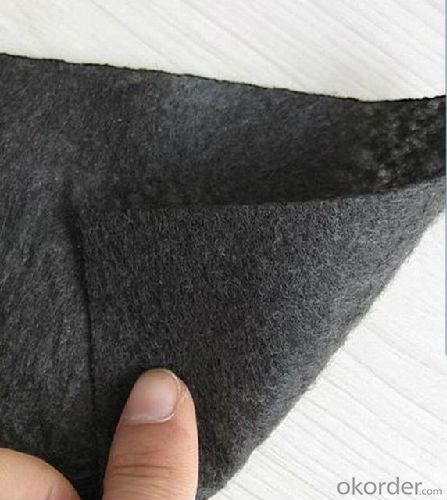
FAQ of our geotextile:
- Q: What can we do for the special customer?
A: Provide custom made service with customer's drawing; We make sure to provide you with the best solutions for your individual case. Whether standard items or non-standard items.
- Q: What can we supply?
A: We provide high levels of communication from start to finish.
- Q: What is our advantage?
A: Top Cemented Carbide has extensive business experience, Fast delivery and high quality.
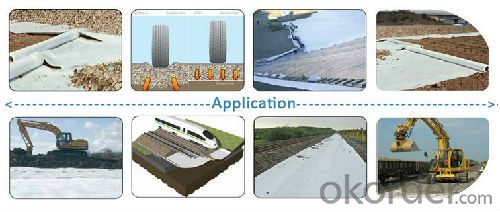

- Q: What are the considerations for geotextile selection in road rehabilitation projects?
- When selecting geotextiles for road rehabilitation projects, several factors need to be considered. These include the type and severity of the road distress, the traffic volume and load requirements, the soil conditions, and any environmental concerns. Additionally, the geotextile's strength, durability, and compatibility with other materials used in the road rehabilitation process should also be taken into account. Proper consideration of these factors ensures that the selected geotextile will effectively enhance the road's performance and longevity.
- Q: Can geotextiles be used in green space development projects?
- Yes, geotextiles can be used in green space development projects. Geotextiles can help with erosion control, soil stabilization, and drainage management, which are crucial aspects of creating and maintaining green spaces. They can be used to prevent soil erosion, promote healthy root growth, and improve water infiltration, ultimately enhancing the overall sustainability and functionality of green spaces.
- Q: What are the specifications for geotextiles in landfill liner applications?
- The specifications for geotextiles in landfill liner applications typically include factors such as the material's tensile strength, puncture resistance, permeability, and ability to withstand chemical exposure. These geotextiles must meet certain standards to ensure effective containment and environmental protection in landfill projects.
- Q: Can geotextiles be used in the construction of underground storage facilities?
- Yes, geotextiles can be used in the construction of underground storage facilities. Geotextiles can provide reinforcement and stabilization to the surrounding soil, prevent soil erosion, and promote proper drainage. They can also help to separate different soil layers and prevent the mixing of materials. Overall, geotextiles can enhance the structural integrity and longevity of underground storage facilities.
- Q: How do geotextiles help with soil reinforcement in mechanically stabilized earth walls?
- Geotextiles help with soil reinforcement in mechanically stabilized earth walls by providing a strong and stable support system. They act as a barrier between the soil layers, preventing erosion and maintaining the integrity of the wall. The geotextiles distribute the load of the soil evenly, reducing the potential for settlement or failure. Additionally, they enhance the overall stability of the structure by increasing the friction between the soil layers, improving the resistance to lateral forces.
- Q: Geotextile gbt-2008.200g / m2 test standard value
- GB / T-2008 is the national executive standard for filament woven geotextile. 200g / ㎡ of the filament woven geotextile warp rupture strength ≥ 50KN / m, zonal rupture strength of the rupture strength of 0.7-1.0 times the elongation at break ≤ 35% weft ≤ 30% , The width of the deviation of -1.0%, CBR breaking strength ≥ 4.0KN, the equivalent aperture O900.07-0.5mm, the vertical permeability coefficient (1.0 ~ 9.9) × (10 negative square ~ 10 negative five times), tear Breaking strength ≥ 0.8KN, irrigation thickness deviation of ± 8%, length and width deviation of ± 2%, sewing strength ≥ breaking strength × 50% KN / m, which irrigation thickness deviation, length and width deviation, sewing strength only on the mold Bag cloth assessment. Under the GB / T-2008 GB standard.
- Q: What is the role of geotextiles in soil reinforcement?
- Geotextiles play a crucial role in soil reinforcement by providing strength and stability to the soil. They are used as a barrier or separator between different soil layers, preventing mixing and maintaining their individual characteristics. Geotextiles also help in distributing the load and reducing the potential for settlement or erosion. Additionally, they aid in filtration, allowing water to pass through while retaining soil particles, thus preventing clogging and maintaining the overall integrity of the soil structure.
- Q: How do geotextiles contribute to land reclamation projects?
- Geotextiles play a crucial role in land reclamation projects by providing soil stabilization, erosion control, and drainage solutions. They are used to separate and reinforce different soil layers, prevent soil erosion caused by water flow, and promote vegetation growth. Geotextiles effectively control sediment migration, improve soil quality, and enhance the overall stability and sustainability of reclaimed land areas.
- Q: Do geotextiles require regular maintenance?
- Yes, geotextiles do require regular maintenance. This includes checking for any damage or wear, removing debris or sediment build-up, and ensuring proper drainage. Regular inspections and maintenance help to extend the lifespan and effectiveness of geotextiles in various applications.
- Q: What are the factors to consider when designing geotextile-reinforced slopes?
- When designing geotextile-reinforced slopes, several factors need to be considered. These factors include the type and strength of the soil, the slope angle, the water conditions, the expected load and stress on the slope, the desired vegetation cover, and the available space for construction. Additionally, the design should account for the potential for erosion and the need for drainage to prevent water buildup. The selection of appropriate geotextile materials and installation techniques is also crucial for ensuring long-term stability and effectiveness of the reinforced slope.
1. Manufacturer Overview
| Location | Taian City,Shandong Province,China |
| Year Established | 2008 |
| Annual Output Value | Above US$100 Million |
| Main Markets | Africa, Oceania, North America, Western Europe, Eastern Asia |
| Company Certifications | ISO9001;IS014001 Certificate |
2. Manufacturer Certificates
| a) Certification Name | |
| Range | |
| Reference | |
| Validity Period |
3. Manufacturer Capability
| a) Trade Capacity | |
| Nearest Port | Qingdao Port;Tianjing Port;Shanghai Port |
| Export Percentage | |
| No.of Employees in Trade Department | 21-30 People |
| Language Spoken: | English; Chinese; |
| b) Factory Information | |
| Factory Size: | 10,000-30,000 square meters |
| No. of Production Lines | Above 10 |
| Contract Manufacturing | Geotechnical Material (Geogrid,Fiberglass/Polyester Geogrid,Geocell,Geonet and Geomat,Plastic Safety Fence) |
| Product Price Range | Average |
Send your message to us
Nonwoven Geotextiles - Filament Spunbond Needle Punched Geotextile
- Loading Port:
- Qingdao
- Payment Terms:
- TT or L/C
- Min Order Qty:
- 10000 m²
- Supply Capability:
- 100000 m²/month
OKorder Service Pledge
OKorder Financial Service
Similar products
Hot products
Hot Searches
Related keywords





















